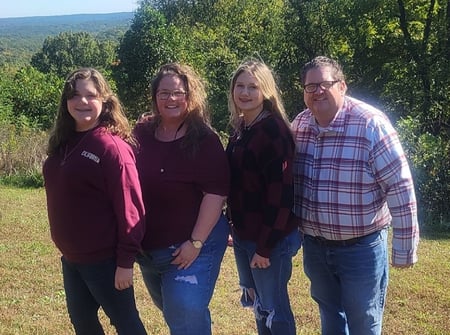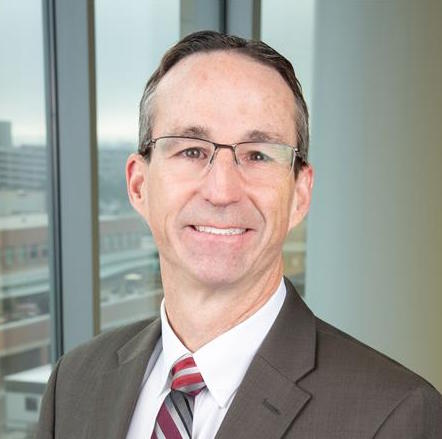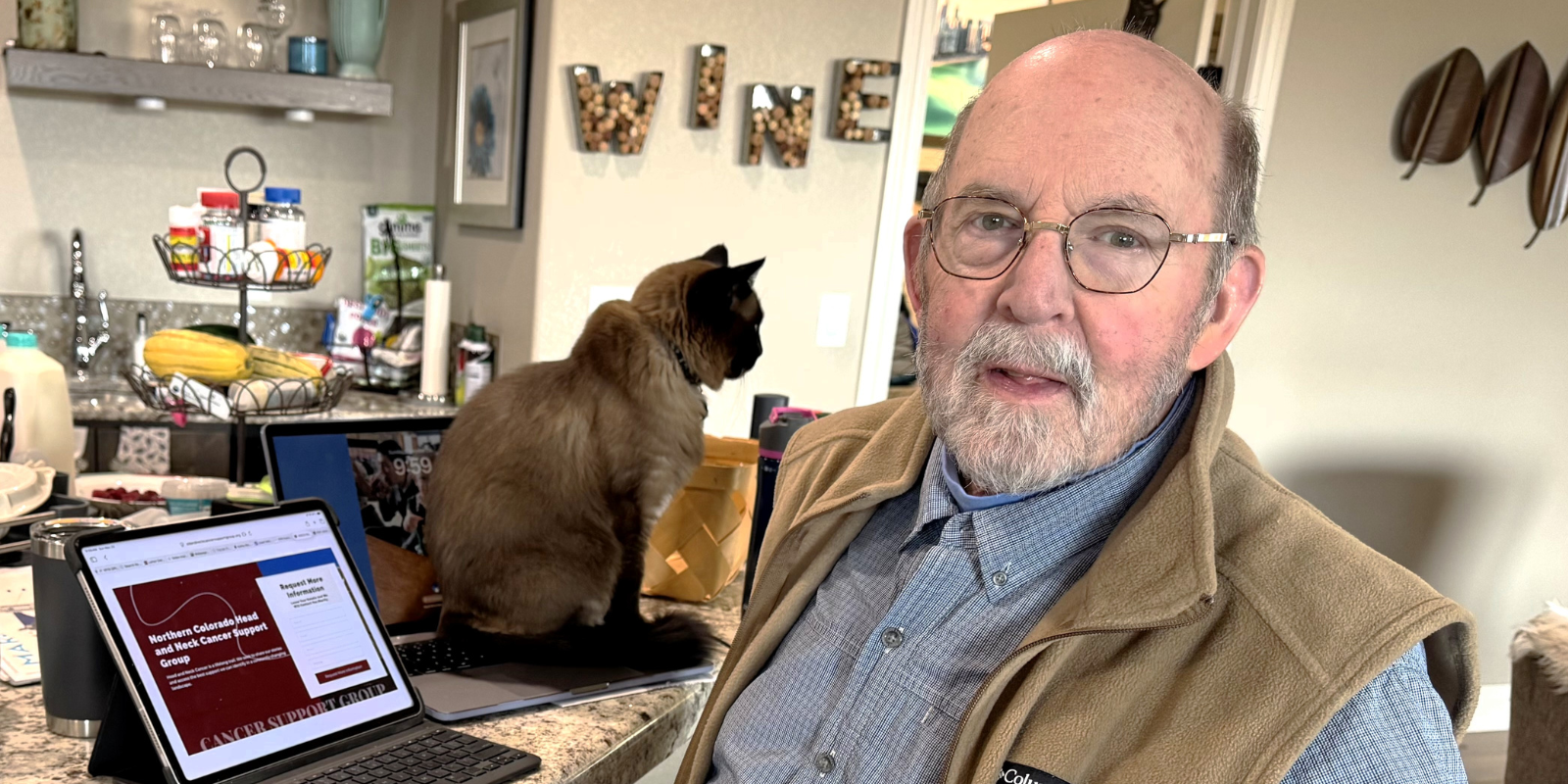Nathan Hammond knew things were getting bad when his doctors had to put the feeding tube in.
Hammond was having so much trouble swallowing his food that his esophagus needed to be bypassed completely to get his body the nutrients it needed. He thought it might be an acid-reflux-related issue that required esophageal dilation, but the true cause of his issues turned out to be even more sinister — a tumor in his esophagus that was blocking his ability to get food into his stomach.
“Back in December of 2021, I was having problems being able to get food down,” says Hammond, 45, who lives in Fort Wayne, Indiana. “I had food coming back up. It took me a while to get in to see the doctor — I called in December, and I got an appointment in February. At that point, it got pretty bad. I think I lost about 30 pounds because I couldn’t eat.”
 Hammond with his family.
Hammond with his family.
Switching care to Colorado
Hammond’s feeding tube was installed a few weeks after his diagnosis, and his oncologist in Fort Wayne started putting together a treatment plan — radiation and chemotherapy, followed by surgery to remove the tumor.
“He was a general oncologist,” Hammond says. “He didn't specialize in esophageal cancer, but he had dealt with esophageal patients before.”
Hammond, however, has a cancer connection that most people in Indiana don’t — his sister, Kasey Couts, PhD, is a researcher at the University of Colorado Cancer Center. Couts went to Indiana to meet with her brother’s doctors, then recommended that he confer with CU Cancer Center members Sunnie Kim, MD, assistant professor of medical oncology at the CU School of Medicine, and Martin McCarter, MD, professor of surgical oncology.
“Dr. McCarter and Kasey have worked together on past projects,” Hammond says. “We were getting advice from him, and there were a couple of recommendations he was making that were different than what the doctors here in Fort Wayne wanted to do. Kasey was also talking to Dr. Kim, and after about a week, she said, ‘Yeah, you just need to bring him here.’ That was the decision.”
Because her brother’s cancer is rare — esophageal cancer accounts for around 1% of all cancers diagnosed in the U.S. — Couts knew it was imperative that he saw specialists who have a deep understanding of the disease and its treatment.
“The GI center here is amazing. They specialize in esophageal cancer, and Dr. McCarter is one of the leading surgical oncologists doing esophagectomies,” Couts says. “Especially with my brother's case being a little more difficult, we really wanted the best of the best.”
Care in multiple dimensions
In Colorado, Hammond’s first visit was with the esophageal and gastric cancer multidisciplinary clinic at the CU Cancer Center, where patients are seen by doctors from multiple specialties —including surgical oncologists, medical oncologists, radiation oncologists, pathologists, dietitians, and genetic counselors — all at the same time.
→ You don’t have to have a family connection to get a second opinion, learn more.
“That instilled a lot of confidence,” Hammond says. “Everybody specifically had experience with esophageal cancer, from the oncologists and the radiologists to the dietitians and the nurses. The doctors in Fort Wayne didn’t have that specialization.”
Kim and McCarter put Hammond on a hefty dose of chemotherapy up front — it’s an approach that isn’t always used for esophageal cancer, McCarter says, but it has shown positive results, especially for younger patients like Hammond.
“Patients generally don't die from local recurrence of cancer; they die because a few tumor cells have already spread microscopically such that we can’t detect them yet,” McCarter says. “The way to get at that is hitting them with chemotherapy first. Chemo goes throughout the whole body, and if there are microscopic cancer cells someplace, the chemo is hopefully going to take care of that before we even get to surgery or radiation therapy.”
Surgical innovations
Hammond benefited from another CU Cancer Center procedure not yet widely used in esophageal cancer surgery — preconditioning of the stomach to ensure the surgery is successful.
“This is a new program we have developed for our esophageal cancer patients,” McCarter says. “We get the stomach ready to do the reconstruction surgery by taking out some of the blood supply to the stomach a few weeks in advance of the surgery. The idea behind that is to improve collateral blood flow to the stomach, so the patient can handle this big operation better. In so doing, we actually have been able to reduce leaks from the connection between the esophagus and the stomach, which historically has been the bane of this operation.”
When it came time for the operation to remove the tumor, McCarter also had to take into account Hammond’s medical history — as a child, he was in a car accident that caused scarring to his chest and bruising on his lungs. There were concerns that the traditional surgery for esophageal cancer, which involves going into a patient’s chest, could be extremely challenging and potentially cause other trauma.
“We knew it would be very challenging, technically, so working with one of our thoracic surgeons, Elizabeth David, MD, we came up with the plan to do a robotic-assisted operation in which we did the reconstruction of his esophagus by making the connection up in his neck in what’s called a transhiatal operation,” McCarter says. “It's something we do occasionally for other situations, but we wouldn't normally have done it for his tumor, given its location. In the end, we did recommend it because of his prior medical issues that suggested that operation would be a better one for him.
“At each step of the way, we were able to personalize Hammond’s cancer treatment, tailoring it to his specific medical issues.”
Taking the next step
When the day of the operation arrived, Hammond was ready. He had been through 11 weeks of radiation and chemotherapy, suffering the side effects of both, and he was excited to take the next step.
“It was good to finally get to that point where the tumor is being removed,” he says. “I had been diagnosed in the middle of February, and it was now the end of July. I did chemo, then I did chemo and radiation, then they give you have a month off to let your body recover before they do the surgery. I was excited to get to that point and to be able to deal with the problem.”
Hammond recovered in the hospital for nine days, then stayed in Colorado for two more weeks before he was strong enough to return to Fort Wayne, where he lives with his wife and two daughters. Life isn’t completely back to normal — he still suffers nausea from the surgery, and he is undergoing immunotherapy to wipe out any last traces of the cancer and keep it from returning — but the feeding tube is gone, and Hammond has been able to return to his job at Essex Furukawa Magnet Wire, where he works as a demand analyst.
“They say it takes about a year for your stomach to recover and get back to normal,” says Hammond, whose faith was a source of strength throughout his cancer journey. “But as a result of what I went through, I’m trying to take advantage of the time that I have and spend more time focusing on relationships with people, especially family members.”
Special specialization
Hammond has that time, he says, because of the care he received at the CU Cancer Center. He is especially grateful for the multidisciplinary clinic and being cared for by oncologists who specialize in esophageal cancer.
“I felt like, ‘In the end, I've only got one shot at this,’ and I'd rather take it in Colorado, where they have the multidisciplinary unit, than with the general oncologist in Fort Wayne,” he says. “Because the CU Cancer Center is a learning environment with a lot of research going on, I felt like there was a lot more specialty there. Everybody I interacted with along the way had that level of specialization, and it made a big difference in the level of care I was able to get.”
Couts add that her brother’s case serves as a powerful reminder of how important it is to get a second opinion when dealing with a cancer diagnosis.
“Especially when you're dealing with some of the less common forms of cancer, being seen by a specialist is really important,” she says. “The cancer treatment field is changing all the time. Results of new clinical trials are coming out that can change the best standard of care for patients moving forward.”




